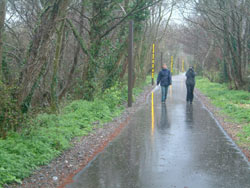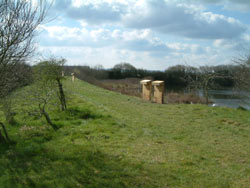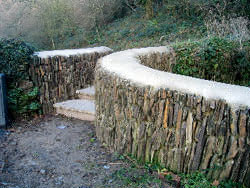Art in the Landscape
The hugely successful 'Art in the Travelling Landscape' project was delivered by Northern Devon Coast & Countryside Service in partnership with Sustrans and was completed in 2000. A number of artworks: benches, waymarkers and shelters were commissioned for the Tarka Trail from Barnstaple to Okehampton. Since then, the Coast & Countryside Service have been working on developing a series of projects under the 'Art in the Landscape' initiative.
The four projects, developed and delivered over a two year period, are intended as pilots that serve to demonstrate what can be achieved and what is possible when the arts are used as a tool within the context of rural regeneration.

Waymarkers along Braunton Cycleway
Artist Kirsty Waterworth with students at Braunton Community College, 2004.
Photo: Lisa Harty.
The Coast & Countryside Service wanted to make people think 'outside of the box' about how artists can contribute to the environment, to see and think about a whole range of possibilities for projects in the environment. Whilst there were of course things that each project had in common - an integrity in their response to the environment in which they sit, and quality in terms of practice and product - it was essential that the four projects offered different opportunities for artists' involvement, therefore demonstrating the range of creative approaches that could be achieved.
How a project is approached is crucial to its success, and not something that is necessarily immediately obvious. The need for development time and the need for the commissioner, partners and project manager to spend considerable time in understanding the aspirations for the project and the context of the site are both critical. They ultimately have a responsibility to invest this time and thought not only in the artist but also in the community that exists on or close to the site.
The other important aspect of these projects to highlight is that they have been championed by an organization that does not have a long term track record of working with artists and is not a traditional 'arts' organization. This is also the case with all the project partners involved in the pilots. This fact alone should give confidence to other similar organizations wanting to get involved in similar creative projects.
So to the projects. Given the objectives mentioned above, the Coast & Countryside Service worked in a whole range of different mediums, from light, stonewalling, writing, sound, to boat building and computer technology. A collaborative team of artist and architect were commissioned, and artists working on their own. There were artists from the West Country and artists from Scotland . One of the artists worked without any direct reference to the nearby community, whilst another worked very closely with the local community. One artist worked with pupils from the local secondary school, another with children from the local primary school. One of the projects was developed in partnership with a very hands-on partner and another with a very silent partner. One artist was appointed by direct approach, another through a selected short list and another by national competition. In the context of good commissioning practice there must exist the flexibility to make the project approach responsive and relevant.
Talking about the work is best done by the artists themselves, so below is just a very brief description of the four projects to whet your appetite.
Westward Ho! Sound Bench by artist Simon Heath was inspired by work developed during a series of workshops with residents in the village where using sound and computer technology creative ideas for the enhancement of Westward Ho! were explored. Sited on the coast path in the village is a bench, just like every other bench, but not! With the action of sitting down on the bench you trigger a random playback of recorded sounds inspired by the village. From poems, to the bingo caller at the arcades, the 200 sounds you hear were recorded exclusively in the village and at a weekend recording event on the seafront in summer 2003.
Velator Wetland Project was primarily about people, access and understanding. The site, owned by the Environment Agency (EA) had been closed to the public. In partnership with the EA a project was developed that involved appointing the artist and architect team, Sans Façon, to realise three very distinct viewing places and spaces, allowing people to look at and experience the wetland site. The artists responded to our desire to use the experience of being on the site as a way of understanding not only the immediate environment but also the wider surrounding environment including the biosphere reserve and to work with the environment and not against it.

Velator Wetland Project by Sans Façon, 2004.
Photo: Lisa Harty.
Nature conservation on the site was a major consideration for the artists to work with. The community aspect to the work was essential and the local secondary and primary schools were both involved in developing projects around the Wetland site. This also led to the production of a teachers' resource pack enabling and encouraging teachers to use the site across the curriculum subjects and a website about the wetland site.
The project at Slade Reservoir, Moth Black, is about demonstrating how the arts can be used to enhance a place, adding that little bit extra. On the site of a newly created permissive path, artist, Phil Power, working with architect Jason Cornish, has created a kissing gate, style and stone wall constructed seating area. Embedded in the path as you climb up to the higher reservoir are solar powered lights that animate your journey and trees have been planted to delineate your intended path.

Moth Black by Phil Power and Jason Cornish, 2004.
Photo: Jennie Hayes.
The fourth pilot project was possibly the most challenging in terms of the technology involved. Working with young people from Braunton Community College and Youth Club, artist Kirsty Waterworth, developed a series of waymarkers that sit proudly along a section of the cycleway running in to Braunton. These columns of steel house LED displays which have running text on them written by the young people. The text is intended to animate your journey along the cyclepath, taking you on a narrative as well as physical journey.
For me, as Arts Consultant to the North Devon Coast & Countryside Service, managing the projects has been a sheer joy, confirming my belief that artists have huge creative hearts and a crucial place around the table in creating and understanding our environments. If you give them the right support and trust, a clear understanding of the commissioners' aspiration, space to dream and think and an exciting site then the sky's the limit.
© Copyright Lisa Harty, December 2004

